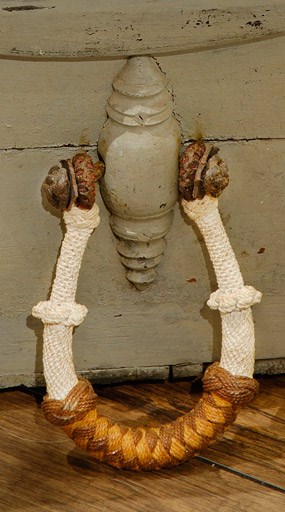
NPS By Ali Maheu, Deckhand, Facilities and Ship's Division, San Francisco Maritime National Historical Park I grew up in the north coast California town of Sea Ranch and was homeschooled from kindergarten through my senior year of high school. One of the requirements for obtaining the equivalent of a high school diploma was to do 40 hours of community service. While growing up I had visited Hyde St. Pier several times with my family and had participated in the Age of Sail overnight program on C.A. Thayer. At the conclusion of the program, one of the instructors had told us that once we were old enough, we could come back and volunteer on the ships. I was then, and am still now wholly captivated by the vessels maintained by the Park, and so I leapt at the opportunity to spend time here at San Francisco Maritime. I had really never planned to, but after my 40 hours of community service were up, I kept volunteering at the Park almost every weekend for more than ten years, and only stopped because I am now a full-time employee here. When I first started volunteering at about age 14, I had little more than the most rudimentary knowledge of boats or the maritime industry, but quickly discovered a passion for traditional vessels, their history and maintenance, and marlinespike seamanship (the art of working with a line or rope at sea, named after the spike-like tool called a marlinespike). I quickly learned how to tie all the common knots, bends, hitches and lashings, do fiber and wire splices and seizings, worm, parcel and serve, as well as traditional hand seaming, canvas work and sail repair with sailmaker's palm and needle. With a background in these fundamentals, advancing into fancy ropework was a natural progression for me. I love examining things and trying to figure out how they are put together, and, also an avid reader, I would pour over tomes dedicated to knot tying, fancy ropework and rigging. Since at that time I did not yet have a boat of my own to decorate in knotwork, I would practice at home. Thankfully, my mother was very patient, and took it in stride when the door handles and railings in our house began sprouting coverings of needle hitching, cocks combing, Turk's heads and coach whipping. During my time here as a volunteer on Balclutha I met another young volunteer named Luc. It was a Festival of the Sea weekend, and we were both volunteering at a demonstration booth, teaching basic knot tying and making Turk's head bracelets for Park visitors. As I recall, Luc was proudly wearing a beautiful fancy knotwork lanyard that he had made for his rigging knife, cleverly hitched out of white cotton. I thought he seemed like a nice sort of fellow, so I struck up a conversation with him by exchanging some tips on how to sew a traditional sailor's "ditty" bag. Luc clearly had interests akin to my own, and after we sat and talked that day about marlinespike seamanship, we ended up dating for nearly eleven years, and are now happily married. Luc and I have continued to pursue our maritime interests into adulthood. Luc went to the California Maritime Academy, and now operates a new-technology Z-drive tugboat in the Prince William Sound region of Alaska for part of the year, but his passion is still for the traditional. We currently own, sail and live on a replica of an 1830 pinky schooner, a once common design of working fishing schooner built primarily in Maine and Massachusetts. We are enjoying working on and maintaining Tiger tremendously, and are especially excited about her new, traditional rigging that we have now nearly completed, using traditional tools and methods. Between Tiger and our mini tugboat Otter, built in San Rafael in 1984 by Bill Garvie, we certainly have found an ideal medium for our fancy ropework skills, from decorative manrope handrails, to hitched rope fenders, to intricate bell ropes. After college, I came to work on the historical vessels here at San Francisco Maritime, and continually put my traditional marlinespike seamanship skills to use. I was recently asked to make fancy "beckets" or ropework handles for a sea chest in the Visitor Center exhibit, "The Waterfront." I have made bell ropes for Balclutha over the years, and numerous other small projects. More often, I do practical knotwork, rigging work, leathering or canvas work, from pitching in to help Balclutha's summer rigging crew sending masts, spars and gear aloft, to doing basic sail repairs on Alma or Grace Quan. Personally, for me, marlinespike seamanship and these traditional skills are tremendously important, not only because they interest me, but because their use and practice have become an integral part of my life, both at work and at home. I am honored when the Park asks me to create a piece of fancywork that will be displayed for the countless visitors attracted here each year to see. As someone passionate about preserving our maritime history and passing on traditional marlinespike skills to others, I think it is infinitely important to pay attention to the small details such as traditional fancywork on the vessels here: While even the most inspired of our visitors most likely cannot run straight home and start practicing traditional rigging, shipwrighting or sailmaking, practical and fancy knotwork skills are quite attainable and useful. After that first spark of inspiration, with the help of a few inexpensive tools, books and materials and a little time and patience for practice, even the novice knotter can start to produce quality decorative or practical knotwork and can maybe even pass on these newfound skills to others. When Park visitors see my work, my hope is that it inspires them to actively learn about and use the marlinespike arts, so that these traditional hands-on skills become more commonplace, rather than being overlooked and forgotten on history's bookshelves. 
NPS |
Last updated: October 5, 2024
